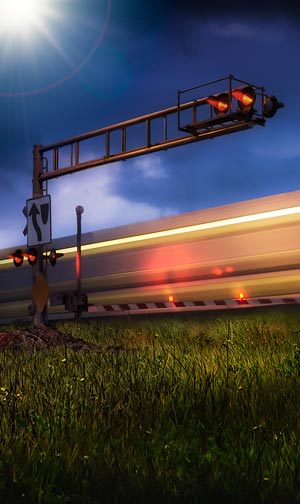Two Injured when Amtrak Train Hits Tractor at Dangerous, Unguarded CSX Crossing
(Monon, Indiana – June 12, 2013)
The total ineffectiveness of passive railroad crossing signage in preventing railroad grade crossing accidents was again demonstrated Wednesday morning when Amtrak’s Chicago-bound “Hoosier State” train with 89 passengers on board struck a farm tractor hauling a tank loaded with 1,000 gallons of anhydrous ammonia at the crossing of CSX railroad tracks and White County Road 200 West just west of Monon, IN. The lessons of past tragedies are obviously similarly ignored by railroad and state authorities.
The crossing, which only has the railroad cross-buck and octangular highway “stop” signs to serve as warning to travelers on the highway of approaching trains, was the site of a tragic accident the morning of March 8, 2010, when the driver of a tree trimming truck was killed by another Amtrak train during heavy fog. One railroad employee and three Amtrak passengers were injured as the tree truck driver was killed by the crushing blow from the train. Ironically, it was also Amtrak’s “Hoosier State”, moving at 60 mph, with the accident occurring at 8:56 A.M. that morning.
In the Wednesday accident, the John Deere enclosed-cab tractor was being operated by David Allen, 40, of Reynolds, IN, who, along with the train’s locomotive engineer, was transported to Indiana University White Memorial Hospital in Monticello, IN for treatment of undisclosed injuries. The victim was northbound on his tractor, hauling the tank loaded with anhydrous ammonia, and the train was traveling west from Indianapolis, IN.
White County North 200 West Road crosses the CSX at an extremely acute 30 degree angle, with heavy tree cover obscuring the view of trains approaching from the southwest. The crossing has two tracks, a main line and a siding, and trains can operate at speeds as high as 60 mph across it. Railroad-supplied information reported to the Federal Railroad Administration claim only two trains, including Amtrak, use the CSX tracks crossing North 200 West daily.
White County Sheriff indicated his relief that the train struck the tractor/tank trailer directly at the connection between the two pieces of farm equipment. The tractor was knocked into a ditch on the north side of the main track while the tank of anhydrous ammonia, which did not leak, remained on the crossing at the siding. “You have a train loaded with passengers, you have the farmer himself, and then you have the emergency personnel responding to the scene, so we’re very lucky” that the hazardous material was not compromised by the collision said Sheriff Pat Shafer to WLFI Reporter Lydia Williams..
A myriad of law enforcement and emergency response agencies, including both the Indiana State Police and the White County Sheriff’s Office, responded to the accident.
This incident happened at a dangerous, unguarded crossing, and was not the first to occur there, either. It is virtually certain that lights and gates would have prevented this incident, as well as the one three years ago. CSX, Amtrak and their industry-controlled Operation Lifesaver public education program all know that lights and gates are the most effective type of protection at railroad crossings. Studies that have been conducted at various times across the past 50 years all confirm the same conclusion: that the combination of flashing lights, bells and crossing gates offer the ability to drastically reduce the number of highway vehicle/train accidents by as much as 96%. Meanwhile, the use of passive signage (cross-bucks, yield or stop signs, for example) have little, if any, protective potential.


